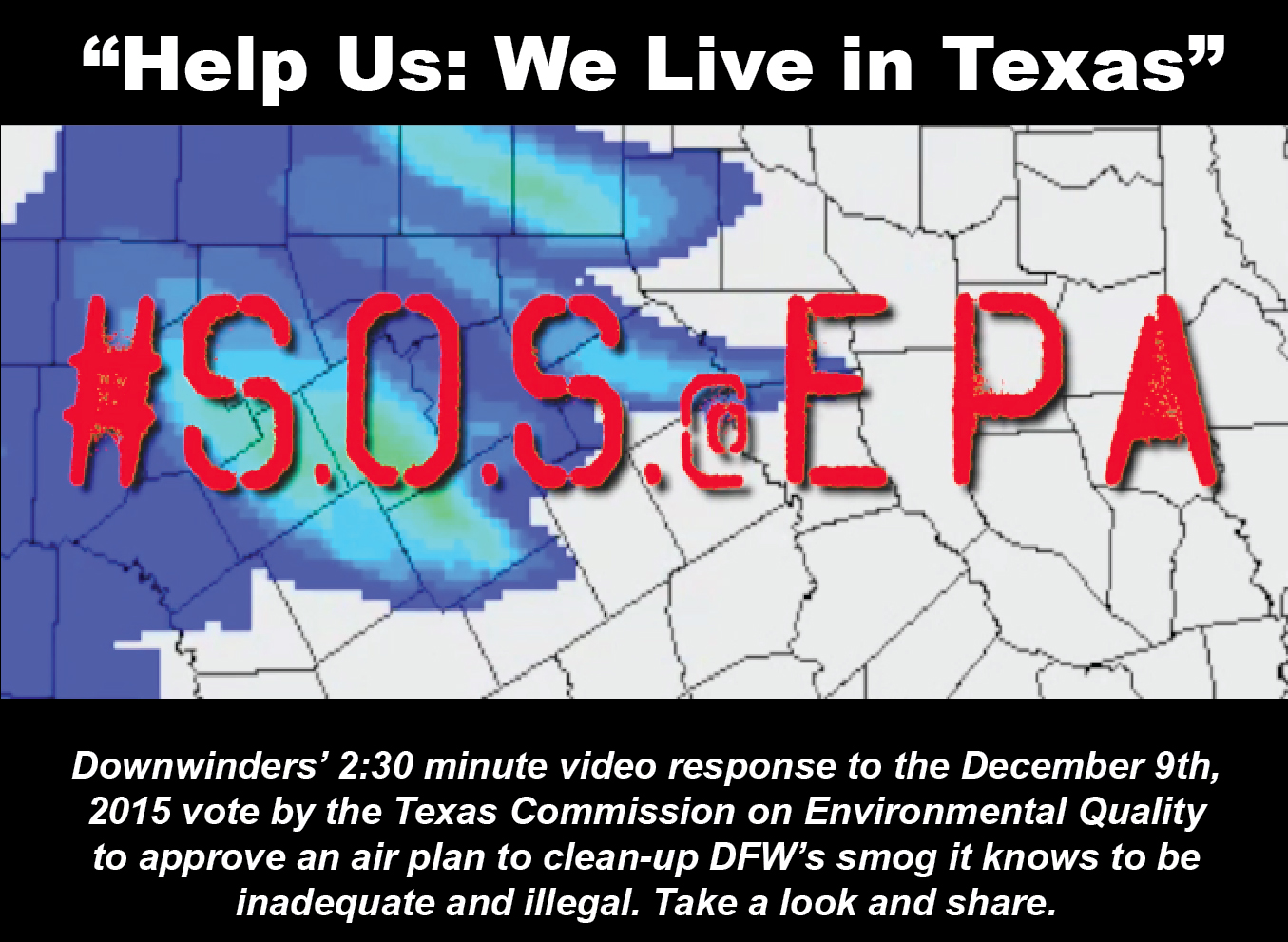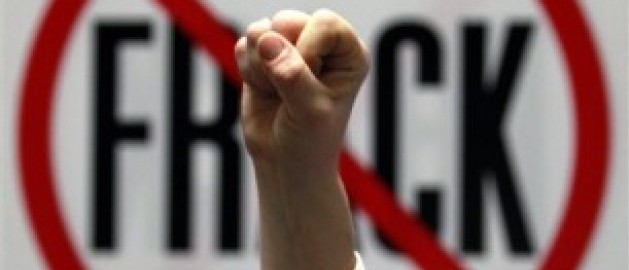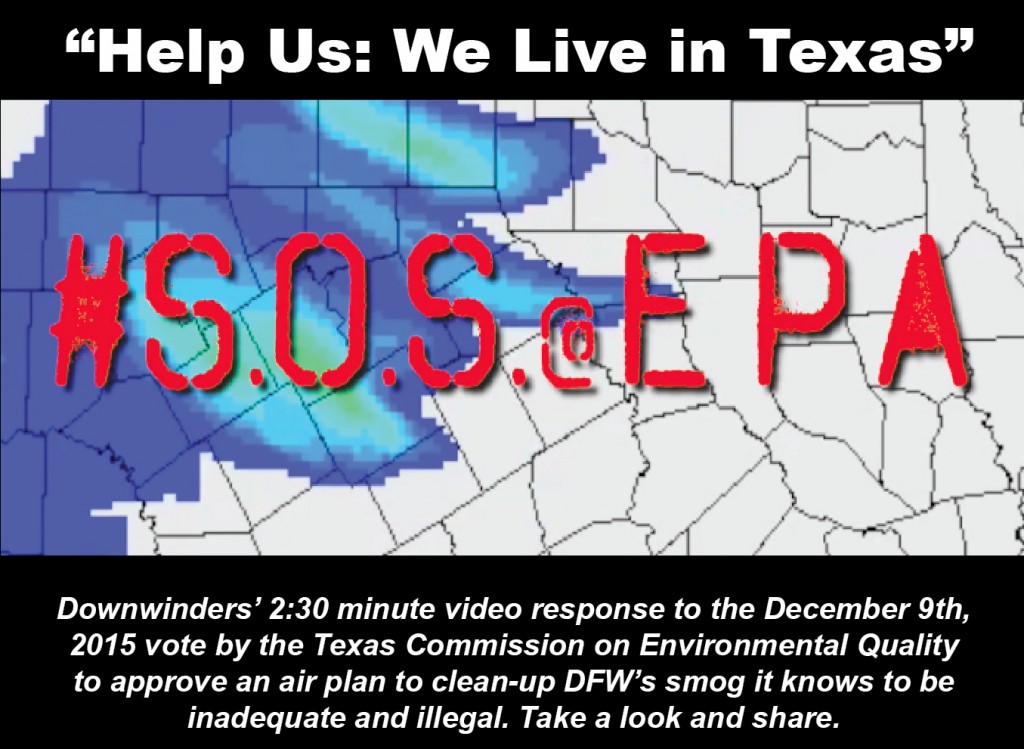Morning News Names Jeff Mosier as its New Environmental Reporter
 Notice came on Friday that the Dallas Morning News had finally decided to fill the environmental beat reporter position left vacant by Randy Lee Loftis' departure. The lucky winner was announced via a response to a reader's comment on a story about the Lake Lewisville BLM fracking lease sale.
Notice came on Friday that the Dallas Morning News had finally decided to fill the environmental beat reporter position left vacant by Randy Lee Loftis' departure. The lucky winner was announced via a response to a reader's comment on a story about the Lake Lewisville BLM fracking lease sale.
"This is just one more reason the Morning News needs an environmental beat reporter," wrote the reader.
"That would be me," replied reporter Jeff Mosier, whose debut under his new job title was that day's story on the BLM fracking lease.
Shortly after, Mosier sent out this "job status" tweet with picture of the Lake Lewisville story, "My debut as environmental writer for @dallasnews. I'll spend more time at landfills than Super Bowls now"
That's a reference to Mosier's stint as a DMN SportsDay reporter covering the Cowboys on and off since at least 2004. Texas environmental politics is definitely a contact sport, but that's not the reason he was picked. He's a News journeyman who came to the paper with a lot of other former Times Herald employees in 1994 and rose through the ranks on a number of different beats. Here's a sampling of his coverage of Dallas City Hall goings-on. So local politics is not a foreign subject matter.
More on point, he was writing for the News' Tarrant County/Fort Worth Bureau in the early stages of the citizen backlash to urban drilling in the Barnett Shale. He's familiar with the issues surrounding fracking and wrote about them from roughly 2009 to 2013. Some examples:
Air tests at natural gas drilling sites fuel concerns in Barnett Shale
State will report today on Barnett Shale air pollutants
Texas House bill seeks to scale back city gas drilling restrictions
Arlington suing Chesapeake Exploration over claims of unpaid natural gas royalties
Cowboys Stadium site isn't expected to be used for gas drilling
From all previous indications, it looked like the News was grooming long-time Educational Reporter Jeffery Weiss to take Loftis' place. Weiss covered the unveiling of Downwinders' UNT Ozone Study and Dr. Robert Haley's Public Health Cost Study back in October, as well as the subsequent Dallas County Commissioners' resolution on reducing pollution from obsolete East Texas coal plants. But apparently Weiss is being put in charge of Energy coverage for the paper.
These moves are all part of a large shake-up of the entire Morning News newsroom as the paper tries to make the on-going rocky transition from print to digital. Lofttis' retirement could have been seen as a chance to do some necessary belt-tightening at the expense of a hunk of coverage. To the paper's credit, it resisted that temptation and named a new environmental beat reporter.
While Mosier's not a complete neophyte, he faces a steep learning curve. Give him some slack as he begins to reacquaint himself with The Way Things Really Work, and let's see if he can provide the public with needed clear-eyed reports from the front.
When Was the Last Time you Saw This?
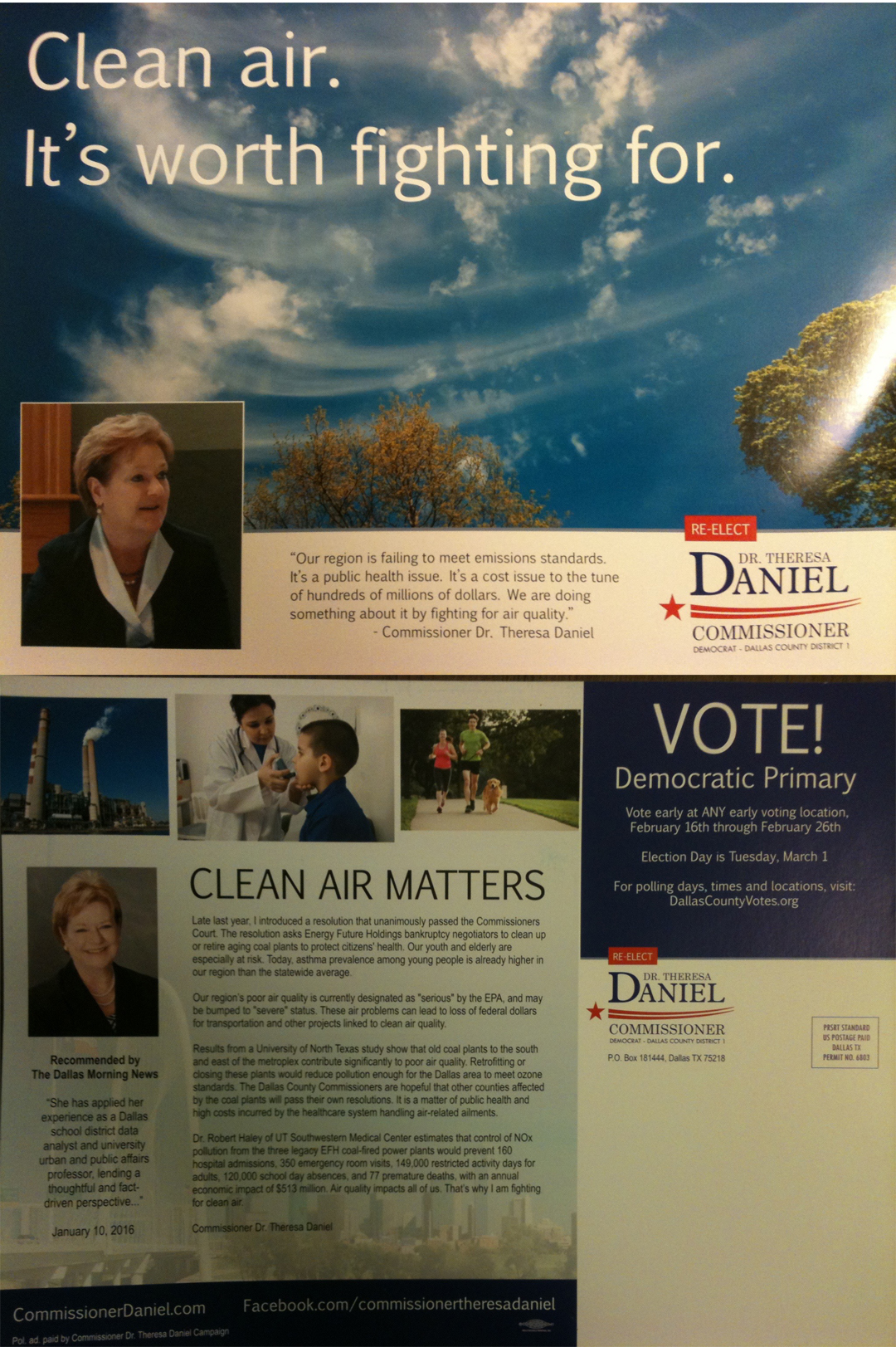 Can you even remember the last time you received a DFW political mailer that spoke about the value of air that won't make you sick or kill you, much less a whole piece devoted to the subject? Neither can we. That's what makes this mailer from incumbent Dallas County Commissioner Dr. Theresa Daniel so welcome.
Can you even remember the last time you received a DFW political mailer that spoke about the value of air that won't make you sick or kill you, much less a whole piece devoted to the subject? Neither can we. That's what makes this mailer from incumbent Dallas County Commissioner Dr. Theresa Daniel so welcome.
In an oversized 9 x11 mailer that went to 5 to 6000 households in District 1, under the headline, "Clean Air. It's Worth Fighting For," Daniel states, "Our region is failing to meet emissions standards. It's a public health issue. It's a cost issue to the tune of hundreds of millions of dollars. We are doing something about it by fighting for air quality."
On the back are four – count 'em – four paragraphs discussing the recent UNT local air quality study Downwinders sponsored, as well as Dr. Robert Haley's associated examination of the costs of dirty air, and the County Court resolution sponsored by Daniel last November asking the judge overseeing the Energy Future Holdings (Texas Utilities) bankruptcy case to clean-up the company's old East Texas lignite coal plants due to their large impact on DFW smog.
This pairing of issue to elected official is a consequence of Downwinders' Ozone Attainment Project, which produced the UNT study, but also put together a committee of local leaders to oversee it. Former Dallas County Judge Margaret Keliher chaired it. During her time in office about a decade ago, Keliher was the most influential local leader on air quality. She rode roughshod over what is now seen as the most effective clean air plan in DFW's two-decade old struggle to meet clean air standards – the one that came closest to working, however fleetingly. With her institutional knowledge of the issues and process, one of the co-benefits of Judge Keliher chairing our UNT study committee was being able to mentor a new generation of local elected officials on air quality.
Commissioner Daniel was one of the most active and vocal members of that committee. By her own admission, she didn't know a lot about air quality at the beginning, but she kept coming to the committee briefings and learning. Over the last year, she's become more confident in her understanding of the DFW dirty air narrative, to the point of now leading meetings with other officials.
Daniel and her fellow Project Committee member Dallas County Councilwoman Sandy Greyson have become a new dynamic duo for the cause of regional air quality. They represent a brand new wave of local leadership on the issue – one that has been sorely lacking even as DFW sunk deeper into chronic dirty air thanks to a state government that doesn't think smog is that big of a deal. You may remember that Greyson testified at the recent Arlington hearing on the State's do-nothing smog plan, and Daniel sent her Chief of Staff to speak. Had they not served on the Keliher/UNT Committee, it's likely neither would have even known about the event.
Even as they become more active, they're drawing more of their peers into the discussion – County Commissioners and City Council members in other parts of the "non-attainment area." For the first time in this decade, clean air has some serious advocates at the local level
Downwinders had a plan. We wanted to take away the state's exclusive power over the model that drives all the clean air decisions for the region and educate elected officials about the importance of winning the fight over chronic smog. We not only got an unprecedented study that used the State's own data to contradict it's conclusions about no new controls needed – we got at least two strong elected officials as new advocates for the cause that were in on that exercise from the beginning.
We didn't know Commissioner Daniel was going to send this mailer out, but it's one more beneficial side effect of grinding things out on a local level.
New Comments from EPA on DFW Air Plan: It Won’t Work
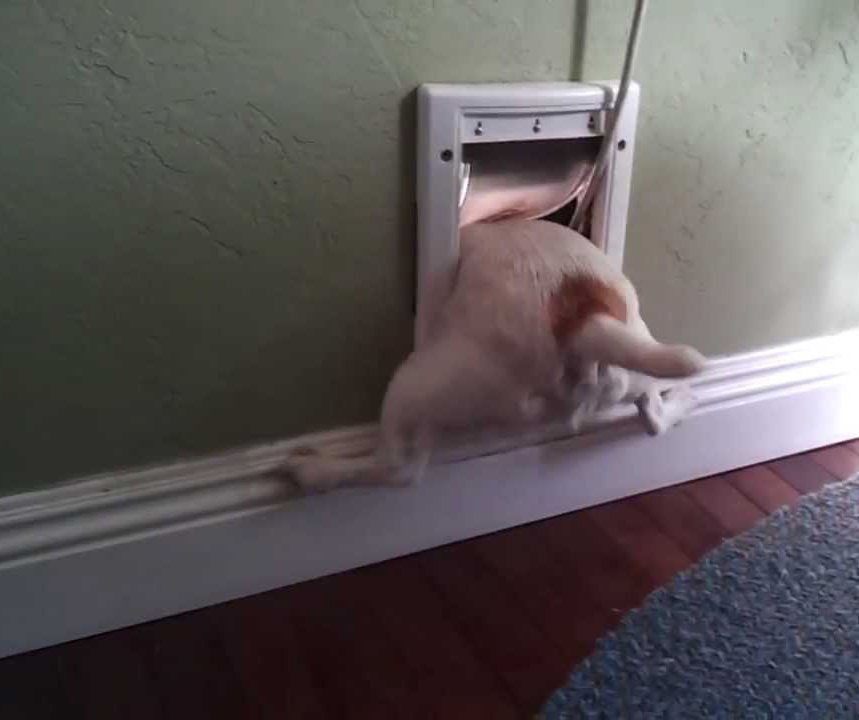 This plan won't work.
This plan won't work.
That's the simple message from the three pages of new comments Region 6 EPA staff submitted to the Texas Commission on Environmental Quality last month concerning its anti-smog plan for DFW.
That message begins with the cover letter, written by Mary Stanton, Chief of the State Implementation Plan Section for Region 6. "… additional local and regional ozone precursor emission reductions will be necessary to reach attainment by 2017."
How much in reductions? EPA estimates an additional 100-200 tons per day more in cuts of smog-forming pollution will be necessary to achieve compliance with the current 75 parts per billion ozone standard. "Without emission reductions on this scale, it is unlikely that the area will attain by the attainment date.”
To give you some idea of how large a number that is, TCEQ calculates that all gas and oil air pollution in DFW equals 78 tons per day, the Midlothian cement plants belch out over 18 tons per day, and all the power plants in the immediate DFW area, 21 tons per day. Totaled, those three sources add up to 117 tons of pollution a year.
All the cars and trucks on DFW roads are said to add up to 180 tons per day of pollution.
So the decrease in pollution EPA is saying is necessary to get down to the current ozone standard is huge.
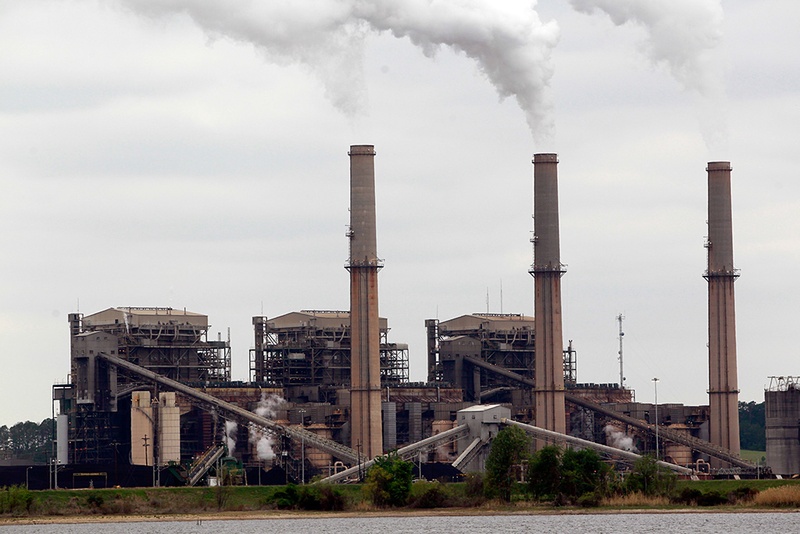
But take a look at those obsolete East Texas coal plants outside the boundaries the DFW nonattainment area. TCEQ says they account for a total of 146 tons per day. Add Selective Catalytic Reduction (SCR) which can get you up to 90% reductions in coal plant emissions, or close them down completely, add decreases from new controls on the cement kilns and oil and gas sources, and you're well on your way to amassing 200 tons a day of cuts in pollution.
Which do you think is more attractive to most DFW residents: permanently parking their cars, or putting new controls on the coal plants? Even though the coal plants harm the whole DFW airshed more than any other major source, they're not held accountable to the same regulatory requirements as sources closer to the center of the urban core, but which have less impact. Our cars must have special gasoline formulas in summer, we have to have HOV lanes, and we still go through Ozone Action Days, but the coal plants party like it's 1979. TCEQ is taking a hands-off approach to the plants and as a result the DFW region will continue to be in violation of the smog standard or huge cuts from other sources will be necessary.
TCEQ could have added new controls to the coal plants to the plan, but it chose not to. In fact, there are no new controls in the state's plan on any major sources of air pollution affecting DFW. EPA's new comments go to the heart of that choice. "Without additional emission reduction measures, we don’t see how the area will meet the standard of 75 ppb by the end of the 2017 ozone season," writes EPA staff.
EPA goes on to say TCEQ's computer modeling supporting it's do-nothing plan is "unrealistic," severely underestimating future smog levels, and delivering projections of decreases "that seem unlikely to be reached."
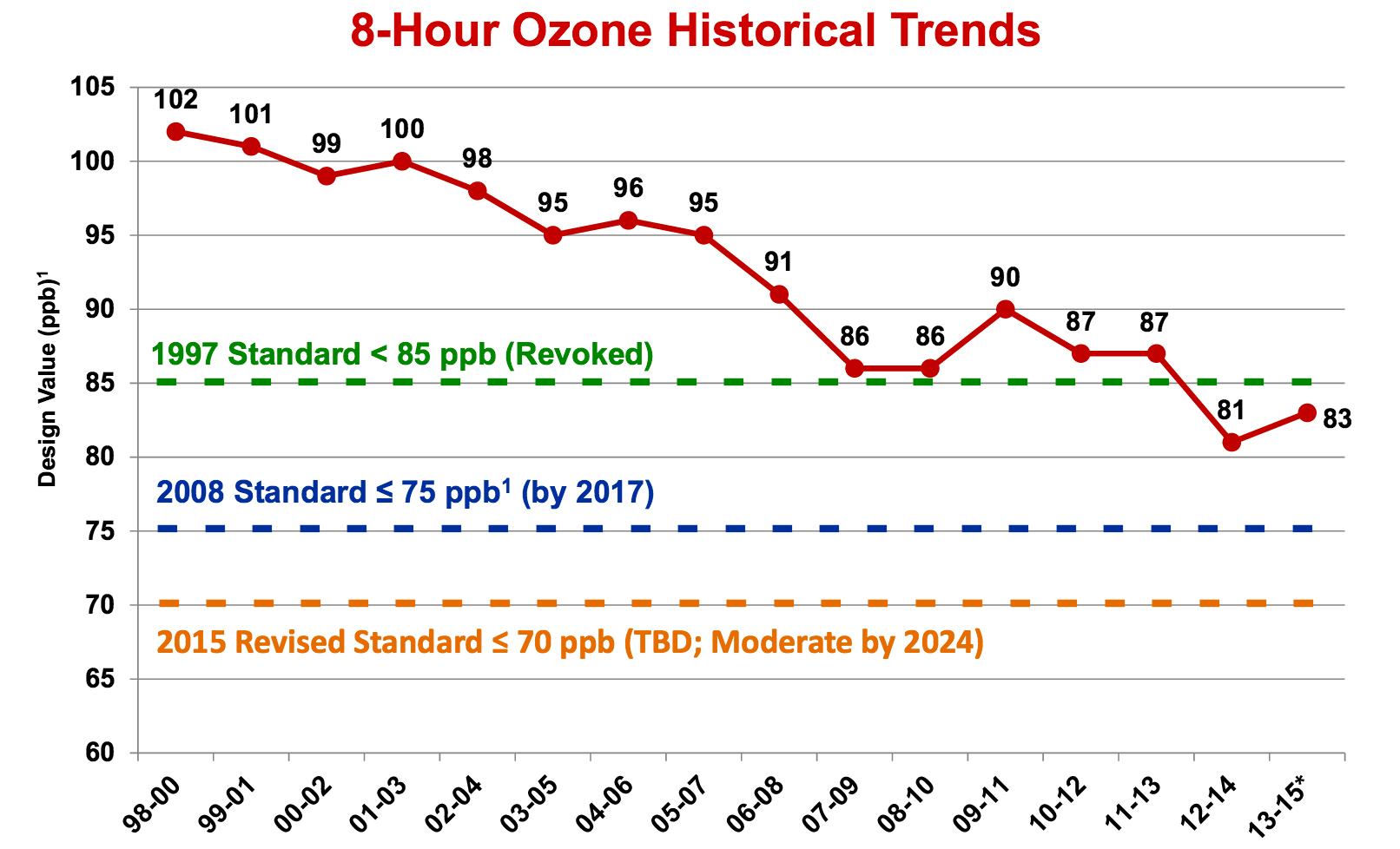 With this stance, EPA seems poised to reject this "attainment demonstration" part of the air plan as being insufficient. But it must wait to see how TCEQ responds to EPA comments about its modeling shortcomings and need for new cuts when the state officially submits its plan this July. Then, and ony then can the Agency approve or disapprove. We're going out on a limb here and predicting TCEQ won't change a thing, thus inviting EPA disapproval.
With this stance, EPA seems poised to reject this "attainment demonstration" part of the air plan as being insufficient. But it must wait to see how TCEQ responds to EPA comments about its modeling shortcomings and need for new cuts when the state officially submits its plan this July. Then, and ony then can the Agency approve or disapprove. We're going out on a limb here and predicting TCEQ won't change a thing, thus inviting EPA disapproval.
That's the pattern TCEQ has already established with its "screw you" response to the EPA's comments about the part of the plan dealing with "Reasonably Available Control Technology," or RACT, last February. This second part decides what new controls should be required of major sources of air pollution within the 10-County DFW "non-attainment" area – like the Midlothian cement plants and the thousands of oil and gas facilities checkerboarding the western half of the Metromess.
TCEQ says nothing new is required. EPA disagrees. EPA told TCEQ last year it had to do a new RACT review and lower the kiln's emission limits to account for a new generation of technology or it would have to reject the state's plan. TCEQ ignored the request, daring the EPA to disapprove. EPA seems more than willing to take them up on the offer.
And so while you're waiting for the state's computer modeling and suspect math to be rejected by EPA in July, you can probably expect to see EPA officially rejecting the RACT part of the state's plan sooner – maybe as soon as the next 60-90 days.
Despite the TCEQ going out of its way to submit an unacceptable plan to EPA, if the Agency pulls the trigger and begins a federal takeover of the DFW air plan, the Commission and the whole of Texas State Government will cry bloody murder about the usurpation of the state's authority and once again proclaim how "out of control" the EPA is on their way to filing suit.
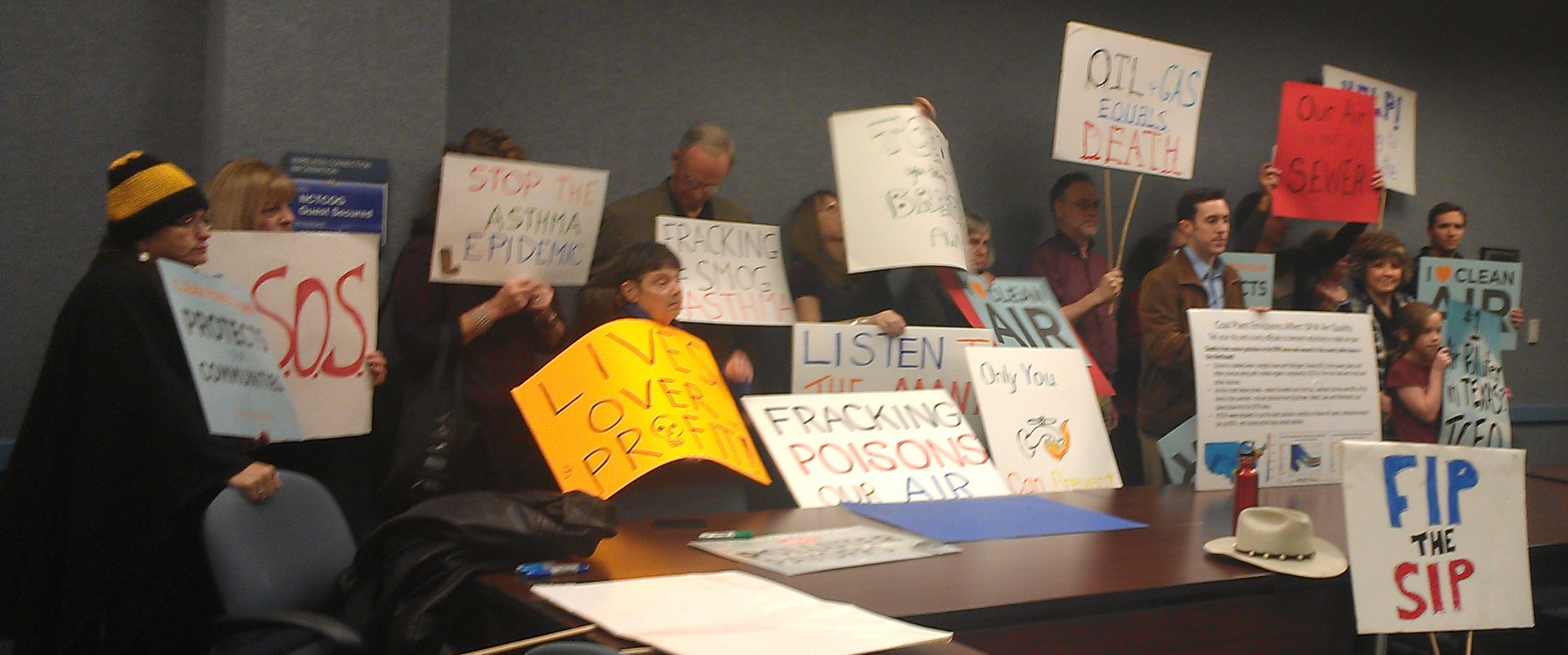 This is why the rowdy eruption of public sentiment for an EPA plan at the hearing in Arlington two weeks ago was so critical (Thank you again). It's also why we now have to be about the business of getting DFW local governments, hospitals and school districts to pass resolutions in favor of an EPA takeover. The Agency will need this kind of public support to counter all the criticism it will take from the Usual Suspects in Austin and DC. If you're interested in helping us pass one of these resolutions in your county, city, school or hospital district, please let us know at: downwindersatrisk@gmail.com
This is why the rowdy eruption of public sentiment for an EPA plan at the hearing in Arlington two weeks ago was so critical (Thank you again). It's also why we now have to be about the business of getting DFW local governments, hospitals and school districts to pass resolutions in favor of an EPA takeover. The Agency will need this kind of public support to counter all the criticism it will take from the Usual Suspects in Austin and DC. If you're interested in helping us pass one of these resolutions in your county, city, school or hospital district, please let us know at: downwindersatrisk@gmail.com
And as always, it's why you, and people you know should:
In Defense of Mary Suhm. No. Really.
Jim Schutze at the Dallas Observer came across an interesting piece of video the other day. It was the deposition of former Dallas City Manager Mary Suhm in the on-going lawsuit between jilted gas driller Trinity East and the City.
In their cross-examination, lawyers for Trinity East are asking Suhm about a secret (at least to the Council and the public) 2008 Memorandum of Understanding between the two parties trading Special Use Permits for gas drilling and production sites the company wanted to access on City-owned flood plain and park land – despite prohibitions on drilling in those places at the time of the agreement – in return for $19 million in upfront leasing payments.
Trinity East's lawyers want Suhm to say the agreement "guaranteed" the permits, and when the Plan Commission subsequently voted to deny them, and the City Council lacked the super-majority to override that denial, the City, by way of its agent in this matter Mary Suhm, defaulted on the agreement.
City of Dallas lawyers want Suhm to say Trinity East executives knew the drilling sites were off-limits at the time they signed the memo and, despite paying the City of Dallas $19 million before they got their permits, the company knew it was not a sure thing. According to the City's lawyers, what Trinity got was precisely what Suhm promised in the agreement: her best efforts to maneuver the company's permits through City Hall bureaucracy.
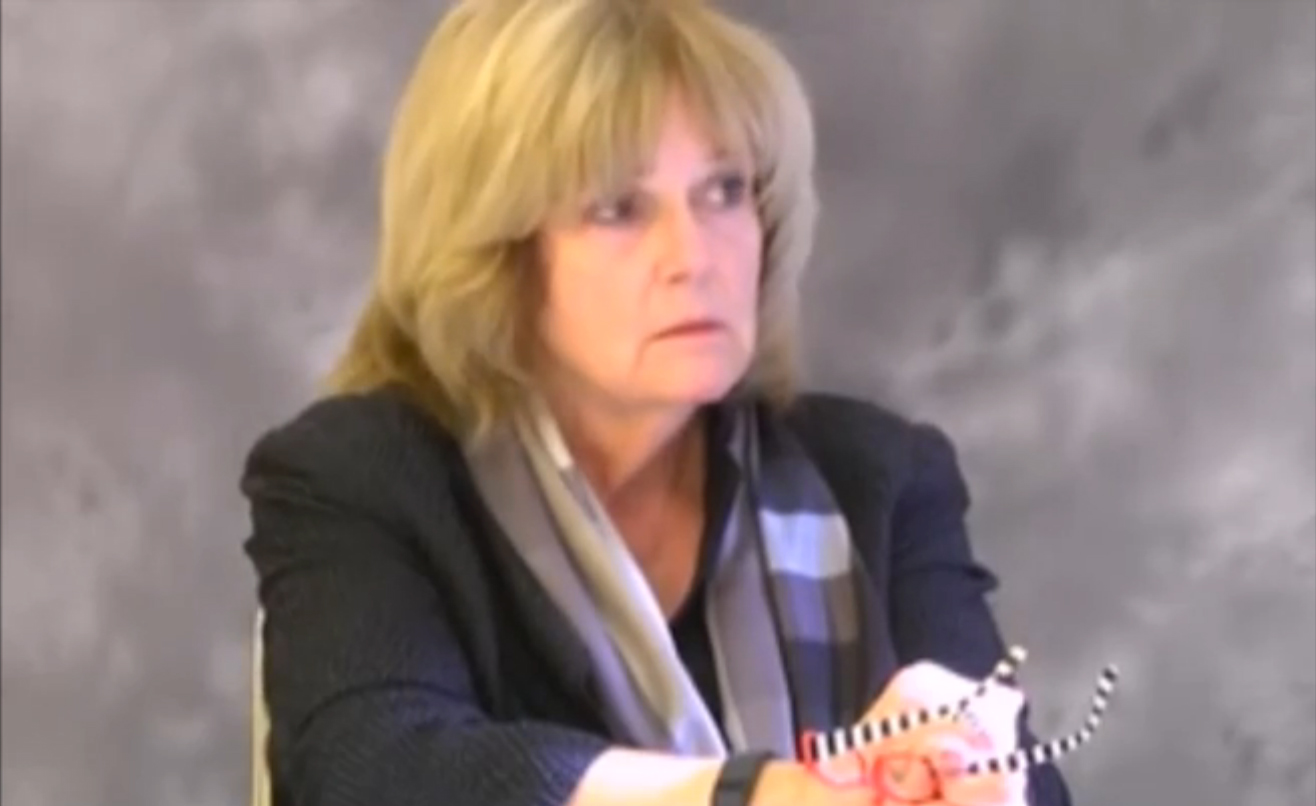 The crux of this back and forth comes at about the 4:30 point of the five minute video when Trinity East's lawyer, on behalf of his client, asks, "What is it they get for their $19 million dollars?"
The crux of this back and forth comes at about the 4:30 point of the five minute video when Trinity East's lawyer, on behalf of his client, asks, "What is it they get for their $19 million dollars?"
Suhm says Trinity East "got the right to apply" for SUP permits.
But those permits cost considerably less than $19 million. What was Trinity East really paying for with those leasing checks, and did they get their money's worth?
Allow us to defend Mary Suhm.
When Trinity East wrote those checks, Suhm was riding high as City Manager and her command over Council affairs was already legend, especially as she negotiated the city budget through very tight times. Trinity knew the signature of a mere elected official was not sufficient. Those come and go at City Hall with hardly anyone noticing. It wanted the boss's John Hancock on the document and the boss was Mary Suhm.
Besides a perfectly legal and hefty bribe when the City needed it during the Great Recession, Trinity was investing in the power of Mary Suhm and her relationships with the Powers-That-Be. The company had every confidence as the ring master of the downtown circus, Suhm could make things happen that otherwise wouldn't happen. She was in control.
Trinity East wasn't wrong – in 2008. Had they pursued their permit requests in the next one to three years, there's every likelihood Trinity East would have received them.
But the company waited until 2011.
What had happened in those intervening three years?
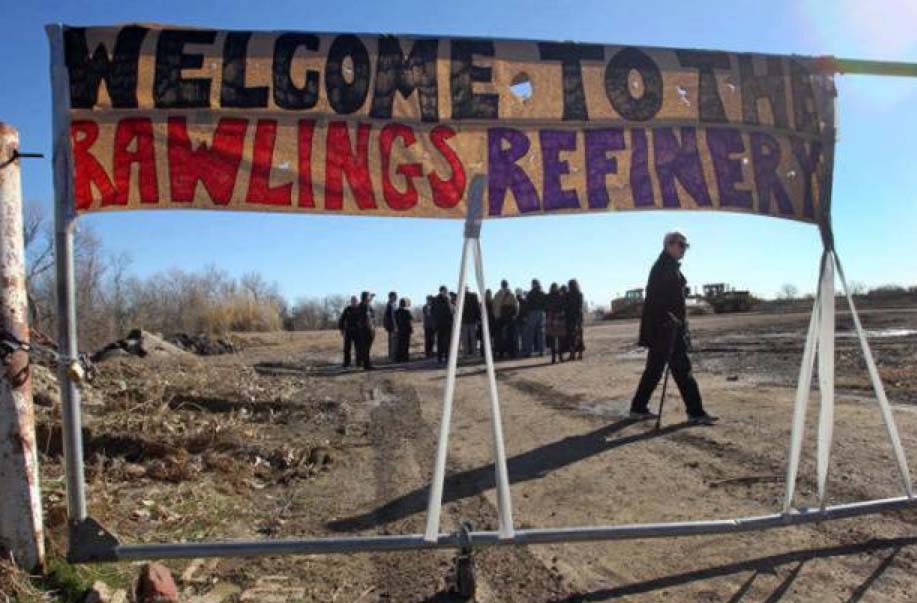
There was a drilling backlash beginning to reach full volume in the Barnett Shale, aided by a new national awareness of fracking as it spread to other parts of the country. Josh Fox's "Gasland" came out in 2010 and was nominated for an Academy Award in 2011. Burning tap water replaced a folksy Tommy Lee Jones as the face of gas drilling in North Texas. Citizen groups were sprouting in every city with drilling fighting for larger buffer zones and more pollution controls. There were stories in the media all the time. Because no health or environmental studies had been done on urban fracking, all kinds of new ones were launched or just being reported on for the first time.
In light of the new controversy, Councilwoman Angela Hunt helped drive the City to convene a gas drilling task force, giving residents a chance to organize around the issue before Trinity East even applied for their permits. Every concern – air, water, even earthquakes – that would later become ammunition for opponents showed up in this task force process first.
Scott Griggs ran for Dallas City Council from one of the districts targeted by new gas drilling permits and won on an anti-drilling platform against an incumbent. He joined Hunt as a fierce critic of Dallas urban drilling. Neighborhoods were showing new muscle.
And so the stage was set for more of an uphill fight than what Trinity probably would have confronted in 2010.
Mary Suhm must have taken note of some of this and sighed when Trinity finally put in for its permits. Now they show-up?
Still, let the record show she put on a stiff upper lip and gave 110% to the cause of getting Dallas City Hall to approve Trinity East's permits. She contorted bureaucracies. She muscled appointees and council members alike. She and her staff worked overtime to try to subvert every move of the growing opposition to Trinity East's permits. When the company lost, it wasn't because Mary Suhm didn't pull out all the stops, but despite the fact she did.
Now, we're pretty sure this is a defense the City of Dallas lawyers don't want to use, but we offer it up here in case they need to break the glass and begin building firebreaks in court to keep from paying back the $19 million.
These are only the most egregious examples residents know about.
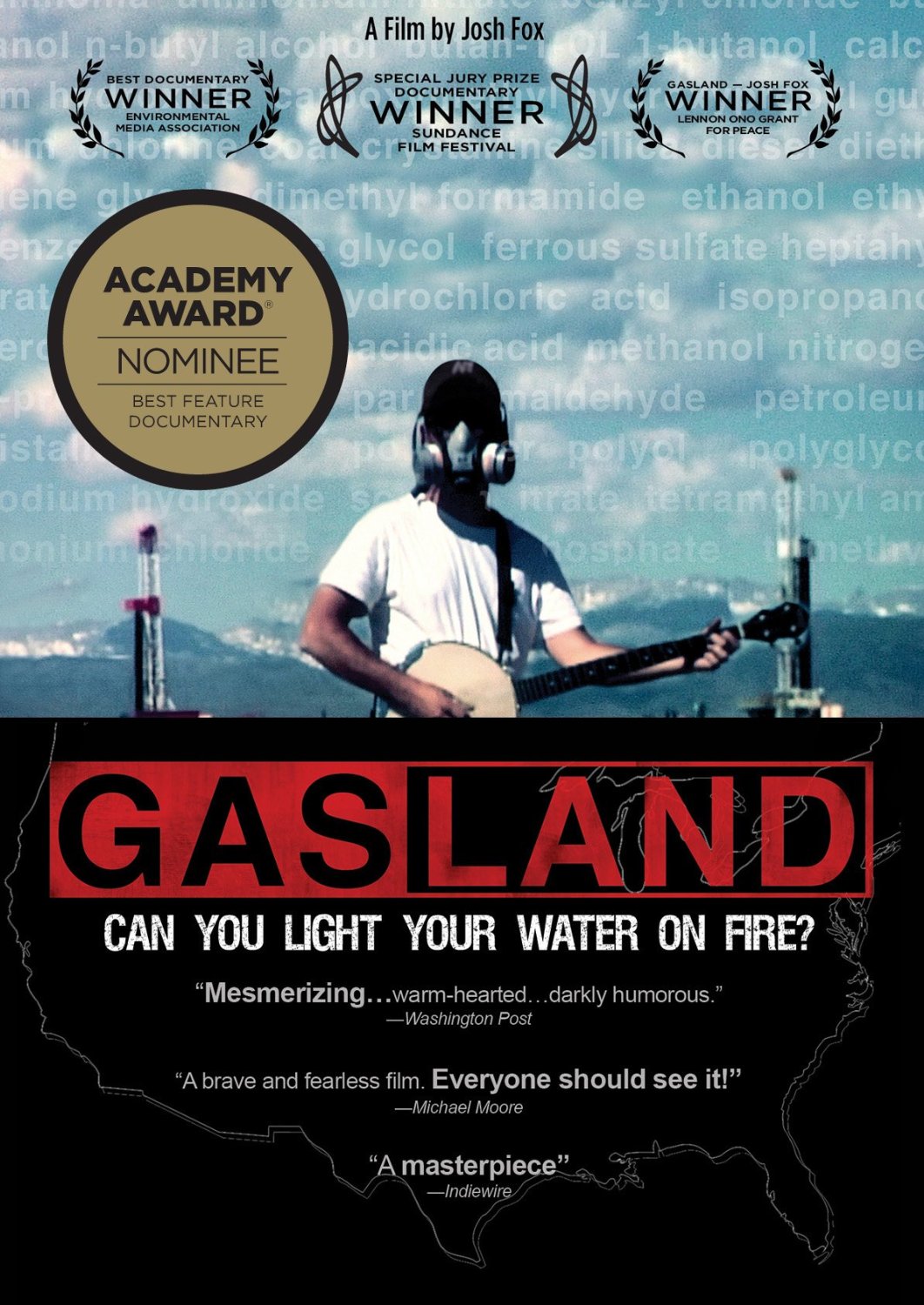
2011 Gas Drilling Task Force
In retrospect, it's easy to see Suhm's manipulation behind the last-minute Task Force endorsements of park and flood plain drilling. And when we say last-minute, we mean it.
Task Force members had already voted to keep the prohibition against drilling in these areas at a previous business meeting. The last meeting of the Task Force was supposed to be a pro forma affair that would ratify all previous recommendations and send them along to Council. Task Force member attendance was therefore down. This is when Task Force Chairwoman and former city council member Lois Finkelman chose to spring new votes on these two issues – and these two issues only – and won a reversal on each. Not only of the Task Force positions – but of current city policy, which of course didn't allow drilling in either area then.
Many excuses were used to justify this re-examination and re-vote that day, but none of them were the truth. Finkelman and staff were doing Suhm's bidding, and she was looking out for Trinity East. While it's not clear if Finkelman knew about Suhm's secret agreement, you can be sure Suhm, or someone on her behalf, made it clear to Finkelman it was VERY important to get these exemptions. Finkelman had been a friend to the clean air movement and other environmental causes during her tenure on the Council in the 1990's, but caved because of her relationship with Suhm, a belief she was helping the City out of a jam, or some other reason. At the end of the day, she weakened proposed city policy in accordance with what Trinity East wanted.
This is certainly something Trinity East got for its $19 million.
2012 Xmas Plan Commission Hearing on Trinity East Permits
Scheduled on December 20th, 2012, this was the first time gas drilling permits had been voted on for Dallas in three years, or pre-national outrage. It occurred before the Task Force recommendations had been considered and adopted into policy. In other words, after a call to reform its outdated drilling ordinance, and after a special Task Force had already been convened and issued its recommendations, Dallas was now about to grant three new permits, including one for a compressor station and refinery, under the old ordinance it was trying to replace. What was the rush? Why not wait and approve new permits until after the Task Force recommendations are written into a new ordinance? Because that would cause further public debate. More debate would highlight the problems of drilling in sensitive areas like park land and flood plains – still off limits in Dallas at the time.
In a transparent attempt to limit public awareness and participation even more, the City decided to hold this important hearing only five days before Christmas. Again, in retrospect, this has Mary Suhm's fingerprints all over it. And it almost worked. But just enough citizens showed up, representing enough well known groups and neighborhood organizations, and citing just enough new facts that had changed the situation since 2008 to win the climatic vote, 7 to 5 at 7:30 pm that evening. It was uncertain which way the decision would go right up until the very end.
Showing-up expecting to lose, instead citizens were elated. Overturning the denial would take a super majority of 12 votes on the Council – something that even then seemed unlikely. Citizens thought they had won. Mary Suhm had tried her best to rig the system, but the rigging failed. She tried again.
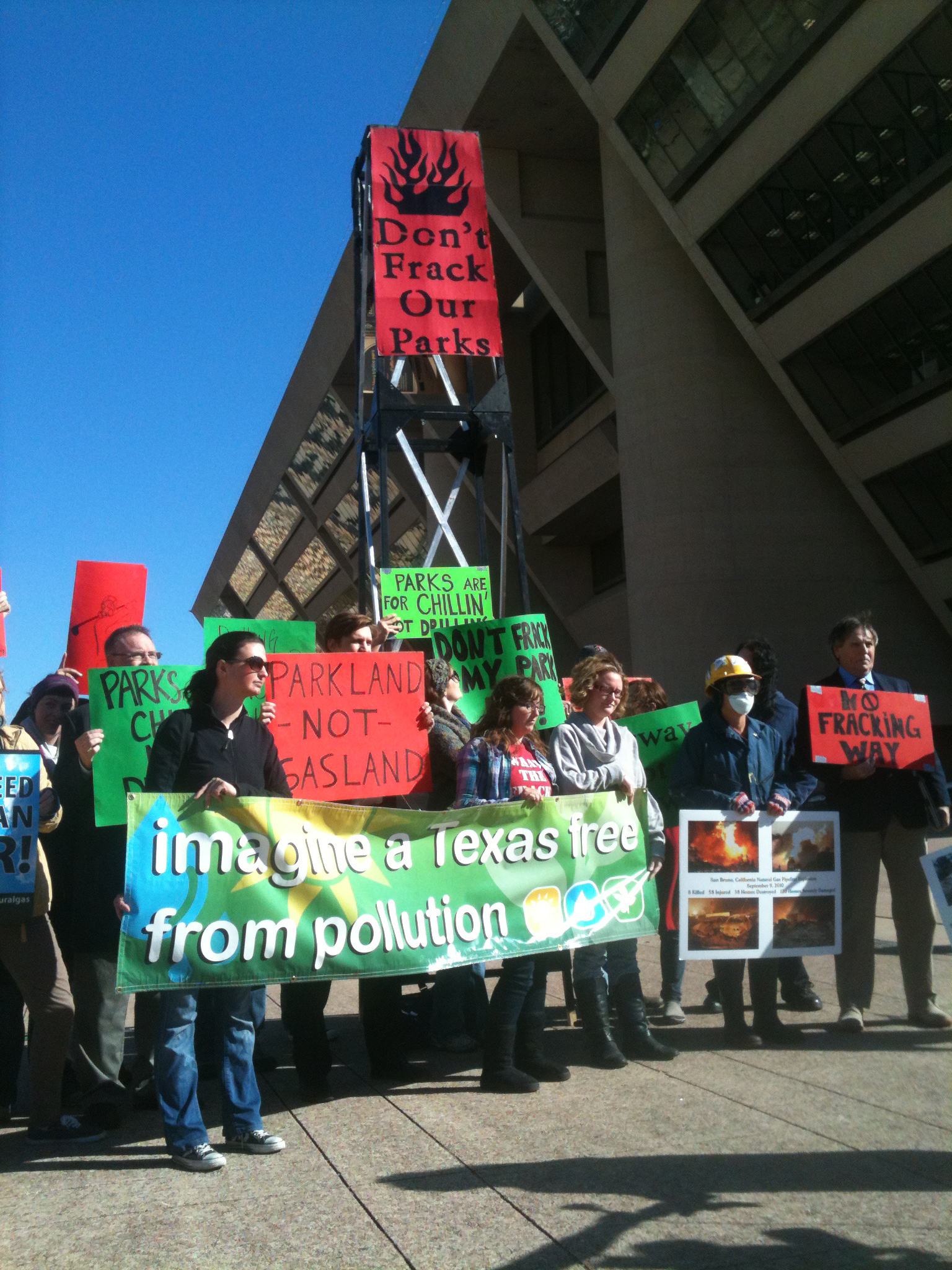
January- February 2013 Plan Commission "Reconsideration Vote" on Previous Permit Denial
Because she'd lost the December Plan Commission vote and knew she might not be able to get the 12 votes on the Council to overturn, Suhm had to do something creative. Viola! The Plan Commission would have a vote to "reconsider" their denial of Trinity East's permits only 21 days earlier. Nobody could remember the last time the Plan Commission even took such a vote. It was unprecedented. It was also Mary Suhm's handiwork.
That do-over decision came at a "special meeting" of the Plan Commission on January 10th, with a 6 to 5 vote to indeed take another vote on Trinity East's permits. This outcome, done under heavy police presence and with no public participation allowed, spurred one of the most iconic moments at Dallas City Hall in recent years – a 3 to five minute spontaneous standing crowd chant of "Shame."
You can see the speed at which Suhm is moving behind the scenes to engineer a better outcome after her unexpected defeat before Christmas. She's doing exactly what she promised Trinity East she would do. She's working the levers. Making things happen that would never otherwise happen. But now, it's costing her more to do so. The contortions of the system necessary to get the permits through are getting more twisted and harder to pull off gracefully. She's gone from talks with friends behind closed doors to forcing awkward "do-over" votes. It was obvious to the public there was something special about these Trinity East permits. Company officials had been dropping hints about some sort of an agreement with the City. Mayor Rawlings said permitting these sites "were a done deal" – although he didn't say why. It was getting messy.
Finally, on February 7th, the day the Plan Commission had scheduled the "do-over" vote, the Dallas Observer broke the story on the Suhm-Trinity East agreement. It was now clear what was driving the favoritism behind the treatment of the Trinity East permits by City Hall – going all the way back to the last-minute reversal of the Task Force, to the Christmas time hearing, to the pending "reconsider vote."
The timing could not have been worse for Suhm. We'll never know what the vote to reconsider might have been were there no headlines pointing to a City Hall cover-up. She may have thought she had the votes to keep the Trinity East permits alive. But with the story breaking that very day, the spotlight was too bright on the Plan Commission to take a new vote. Citizens won a reprieve and eventually a victory as the Commission requested the City Council deal with changing the current prohibitions against parkland and floodplain drilling before asking them to violate current ordinances again. That never happened. Instead, the three Trinity East permits were again denied by the Plan Commission in March 2013, albeit by razor-thin 8 to 7 and 9 to 6 margins.
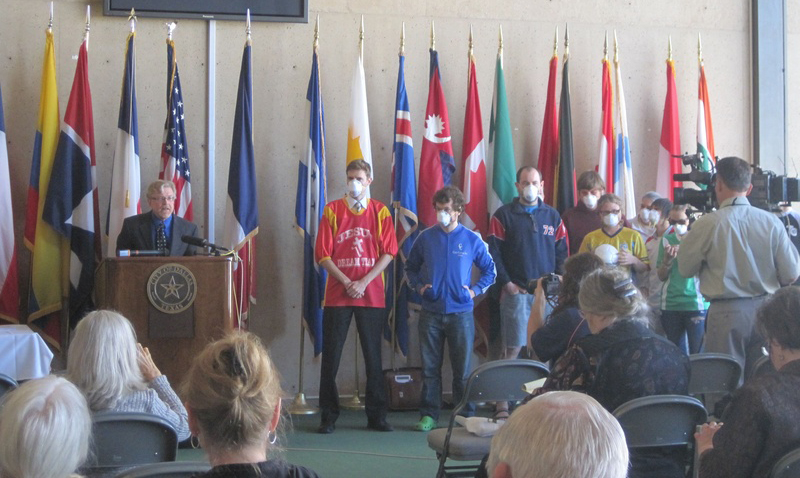 And that was that. Suhm was gone in four months. Officially it wasn't because of the cover-up of the Trinity East agreement, but of course everyone knew it was because the whole thing was headed to court one way or the other.
And that was that. Suhm was gone in four months. Officially it wasn't because of the cover-up of the Trinity East agreement, but of course everyone knew it was because the whole thing was headed to court one way or the other.
Although the Mayor tried to rally 12 votes on the Council to overturn, he couldn't do it. The prospect of the kind of rolicking citizen protests keeping the Plan Commission on the 6 o'clock news showing up at a Council Meetings could not have helped his cause at this point.
Urban fracking opponent Philip Kingston had replaced Hunt on the Council, Griggs was still there, and they were joined by enough other council members (Sandy Greyson, Monica Alonzo, Carolyn Davis, and Adam Medrano) to insure the Plan Commission vote would prevail.
At the end of the day, Trinity East walked away empty-handed. but make no mistake about it. Mary Suhm did all she could to subvert the system for Trinity East.
Had the Dallas Observer not revealed the secret agreement, she might have even won the day for the company and still be City Manager. Was it $19 million worth of subversion? At today's inflated rates, who knows? But other than funding a small army and declaring herself dictator of the Drilling Republic of Dallas, she did all she could.
If you're Trinity East you can complain about the outcome, but you can't complain about her effort. There were too many variables out of her control for once. Not the least of which was a vigorous, rowdy, neighborhood-based movement against urban fracking in Dallas that was taking the fight to the public square…and winning. Sometimes, even the most powerful City Manager is on the wrong side of history.
Thank You…for Kicking Serious State of Texas Butt Last Night
 Those were not your father's treehuggers that showed up in Arlington last night.
Those were not your father's treehuggers that showed up in Arlington last night.
Over 100 people, including 36 speakers over three hours, provided perhaps the angriest, and certainly the most profanity-laced evening of testimony ever heard in the two-decade history of state public hearings on DFW's dirty air. It's as if frustration over the last 20 years of State failures had finally found a cathartic, public release.
For the most part, speakers from communities across North Texas ignored the State and spoke directly to representatives of EPA, pleading for the Agency to take air quality planning out of the hands of a hostile Texas Commission on Environmental Quality.
But when many speakers did address the State's efforts, they didn't parse any words – at least any words that can be printed in a family newspaper, or this blog. For the first time anyone can recall, f-bombs were hurled at TCEQ over its failure to take North Texas bad air seriously. Dallasite Gary Stuard set the tone for the event early on by saying it was time for residents "to quit being so polite" about their systematic poisoning. His message was taken to heart by many of the speakers that followed.
Old, young, male, female, Black, White, Latino, mainstream group, neighborhood group, Elected officials, students, business owners, doctors, asthma suffers, parents of asthma suffers, people concerned about climate change, about fracking, about coal plant pollution, about cement kilns – it didn't matter. Not a single speaker spoke in favor of the State's plan of doing nothing about rising smog levels.
Seizing on the day's headlines, Lance Irwin from Mansfield was the first, but not last person to compare the official neglect over lead in Flint, Michigan's water supply to pollution in DFW's air supply. Arlington residents spoke – and in one instance, sung – movingly about fracking contamination making their neighborhoods unlivable. More than one testimony was dedicated to a friend or relative who'd died from a lung disease. Equal parts despair and anger.
By the time the final speakers finished, it felt more like a church revival. The Church of the Unredeemed State Agency. When was the last time you heard people say they had "fun" at a pro forma public hearing?
To be sure, more traditional voices and statements were in full force. Congresswoman Eddie Bernice Johnson sent a staff member urging the State to redo its plan. Dallas County Commissioner Theresa Daniel sent her aide to talk about the need to control coal plant pollution in the plan. Dallas City Councilwoman Sandy Greyson spoke for the need to grab this opportunity to make progress. Dr. Robert Haley of the Dallas County Medical Society and UT-SW did an excellent job of summarizing his recent study on the public health and economic costs of DFW smog and speaking to the Texas Medical Society resolution against the state plan. Rita Vinson, newly elected President of the Fort Worth League of Neighborhood Associations read a unanimous resolution passed by her group only the day before, calling for EPA to reject the plan. Lots of speakers recounted the long and winding road leading up to the current fact that DFW now has worse smog than Houston.
But it was the tossing aside of business meeting protocol and the pretense that the State had any interest in being there that made this a milestone event. Veterans of past hearings talked about how tired they were of repeating themselves. Newcomers couldn't understand how a State government that doesn't think smog is bad for you can write an effective anti-smog plan. Dentonites were rightfully resentful of seeing a plan that does nothing about smog from oil and gas sources being promoted by the same government that stole its municipal rights to regulate it themselves. Coarseness in language reflected rawness of feelings over yet another Texas attempt to undermine the EPA.
Although the weather was nasty, the major obstacle organizers faced yesterday was understandable skepticism about what good it would do to go to another useless TCEQ hearing. The answer was the need to provide EPA with political support to prepare for a federal takeover. That happened. Big Time. For three solid hours.
Thank you to everyone who participated in the worst public ass-kicking the TCEQ has ever received in DFW.

Now what?
EPA sent three staff members, including those in charge of reviewing and commenting on the State plan. They took notes. We'll get to see what the Agency thinks about this "new" plan within the next three weeks after the comment period closes and its written review becomes part of the public record.
After that, it should be a relatively short time before EPA decides to officially reject the part of the plan dealing with new controls in the 10-County "non-attainment area" – the part the State didn't do even after EPA asked TCEQ to, and explicitly told the Commission it would reject the plan unless it did.
It will take EPA longer, perhaps until the end of the year, to make a decision about the rest of the plan – the part that relies on computer modeling and estimates of future pollution. It's more technically oriented and there's more nuance than the up or down legal opinion with the control section.
And for citizens?
Send an email to EPA urging them to reject the State's awful air plan for DFW
Sign the CHANGE.ORG petition urging EPA to reject the State's plan
Forward our two-and-a-half minute video to people you know are concerned about air quality – or should be.
Submit written comments on this plan to the TCEQ:
Please reference: "Dallas-Fort Worth Attainment Demonstration for the 2008 Eight-Hour Ozone Nonattainment Area, Project Number 2015-014-SIP-NR"
via the interwebs:
http://www1.tceq.texas.gov/rules/ecomments
or fax
(512) 239-6188
Or by snail mail:
Kathy Singleton,
MC 206,
Air Quality Division, TCEQ
P.O. Box 13087
Austin, Texas 78711-3087
And get ready to campaign for resolutions supporting an EPA clean air plan for DFW from your local city council, county government, hospital districts, and school boards. We're all about building support for a federal takeover of our air quality planning between now and the end of the year when EPA is expected to make its final decision. We're coming to a governmental entity near you!
Lots is at stake. We can win the largest improvement in DFW air quality in a decade or wait another five years to try. Thursday night's showing makes clear many of us aren't willing to wait.
Onward Thru the Smog.
The First DFW “Clean Air” Plan Rejected by Doctors
 Public Hearing
Public Hearing
6:30 pm Thursday
January 21st
616 Six Flags Drive Arlington (near I-30 and Hwy 360 – map)
– First come, first serve to speak (no reserved time)
– 3-5 minutes speaking time
– Talking Points here if you need them
– NEW! Sierra Club Event at 6 pm out front
How bad is the new State of Texas "clean air" plan for DFW?
So bad the Texas Medical Association passed a resolution to reject it.
That's the Texas. Medical. Association.
As far as we know, this is the first time the state's premier medical association has expressed a formal opinion about any state air plan.
They oppose the State's plan because it contains no new controls on any sources of pollution contributing to North Texas' chronic smog problem. Not a one. At a time when DFW smog levels are going up.
They oppose the State's plan because it allows dirty air in North Texas to keep killing people and making them sick, costi us $650 million every year. Human and financial costs which are completely preventable.
Join the TMA in taking a public stand.
Residents of Texas who want clean air have to speak-up to counter our State officials who ridicule the idea.
Come to the hearing on Thursday evening and tell the State why you don't trust them with your health. Urge the EPA to reject Austin's plan and write its own.
What the Docs Say:
Some of the harshest critics of the State's proposed do-nothing DFW air plan aren't members of any environmental group. They're doctors.
At its 2015 convention in November, the Texas Medical Association endorsed a resolution urging the Association to:
"…reject the Texas Commission on Environmental Quality's (TCEQ's) 2015 State Implementation Plan (SIP) report and advocate for development of a new SIP report that conforms to the scientific, peer reviewed modeling methods developed by UT Southwestern and University of North Texas experts. TMA advocates for implementing reasonably available control measures at the state level capable of meeting national ozone standards, based on the UTSW and UNT validated models."
The resolution was the work of a delegation from the Dallas County Medical Society, headed up by Dr. Robert Haley, Epidemiologist at UT-Southwestern.
It was Haley who worked on a landmark study on local impacts of ozone that was released in tandem with Downwinder's own UNT computer air modeling study last fall. Those are the UTSW and UNT studies referenced in the TMA resolution.
Dr. Haley took the EPA's own software for estimating the health and economic costs of bad air, and applied it to DFW. What did he find?
Reducing smog by just 5 parts per billion in North Texas would:
1. Prevent 200 admissions to hospitals for respiratory illness every year
2. Prevent 400 ER visits to hospitals for respiratory illness every year
3. Prevent 140,000 lost school days every year
4. Prevent 100 premature deaths every year
5. Save $650 million a year in lost productivity
As it so happens, the most cost-effective path to lowering ozone levels across the region has been mapped out by the UNT study, which cloned the State's own computer model for DFW and ran the "what ifs" Austin isn't interested in asking anymore.
Applying off-the-shelf technology to East Texas coal plants, Midlothian cement kilns, and oil and gas facilities was shown by the UNT study to be the easiest ways to get smog levels down enough to comply with the current federal ozone standard. That's the "reasonably available control" part of the TMA resolution.
The State knows all this but refuses to include these controls in any DFW air plan – for the second time in 5 years.
Dr. Jim Walton, President of the Dallas County Medical Society took on that official stubbornness in a full-page editorial running in the group's newsletter:
"…once again TCEQ staff has announced that it sees no need to require new control measures on any major pollution sources, even while the Commission's own computer air modeling shows that DFW will remain above the 75 ppb standard….DFW is a chronic Clean Air Act violator, and much of it is avoidable. We can and should lead in this very practical and real issue that continues to threaten the health of our community."
And doctors are leading on this issue.
Despite the Dallas County Medical Society hosting its annual dinner on Thursday evening, Dr. Haley has said he'll join us in Arlington for the air plan hearing because of its importance. Come and thank him in person by adding your voice in urging EPA to take over the region's air plan.
Fight Back.
Don't Let Gregg Abbott Speak For You on This Important Issue.
Thursday, January 21st
6:30 pm
616 Six Flags Road in Arlington
First Floor Meeting Room
THE CASE FOR EPA TAKEOVER OF DFW AIR PLAN
Sign the CHANGE.ORG petition to EPA urging the Agency to reject the State's plan.
The Fastest Way to Get Big Cuts in Fracking Pollution? A Good DFW Smog Plan.
Public Hearing on DFW Air
Thursday, January 21st
6:30
616 Six Flags Road in Arlington
(Map)
If you're fighting fracking in your North Texas community, you have few options these days. The State of Texas is not only very not interested in hearing about fracking problems, it just passed a law that makes it illegal for your city to be too interested in hearing from you about those problems as well.
Enter another DFW anti-smog plan. In the past, these plans have been written by Austin and have tired their best to ignore the large volumes of smog-forming pollution from oil and gas sources. This new plan is no different. Left up to the State, there would be no new cuts in pollution from any major industrial source, including the gas industry.
But EPA may not leave it up to the state this time. There are already indications the EPA will reject the State's air plan for DFW as being inadequate and draft one of its own. That would be good news for local anti-fracking activists. Why? Because it could mean cutting lots and lots of different kinds Barnett Shale pollution throughout the region and help shift the costs of its harmful impacts to industry.
That's why if you're concerned about fracking, you owe to yourself to show-up at this Thursday's public hearing and tell the EPA you want them to reject the state's do-nothing air plan and instead implement a "Federal Implementation Plan" to clean up DFW's chronically smoggy air.
The Case For Cutting Oil and Gas Pollution in a DFW Anti-Smog Plan
1. The Oil and Gas Industry is a Large Source of Smog Pollution in North Texas
Look at the chart below for where and in what volumes the State believes smog-forming pollution will be coming from in 2017. The numbers are directly from the Texas Commission on Environmental Quality's DFW air plan. It's in TONS PER DAY.
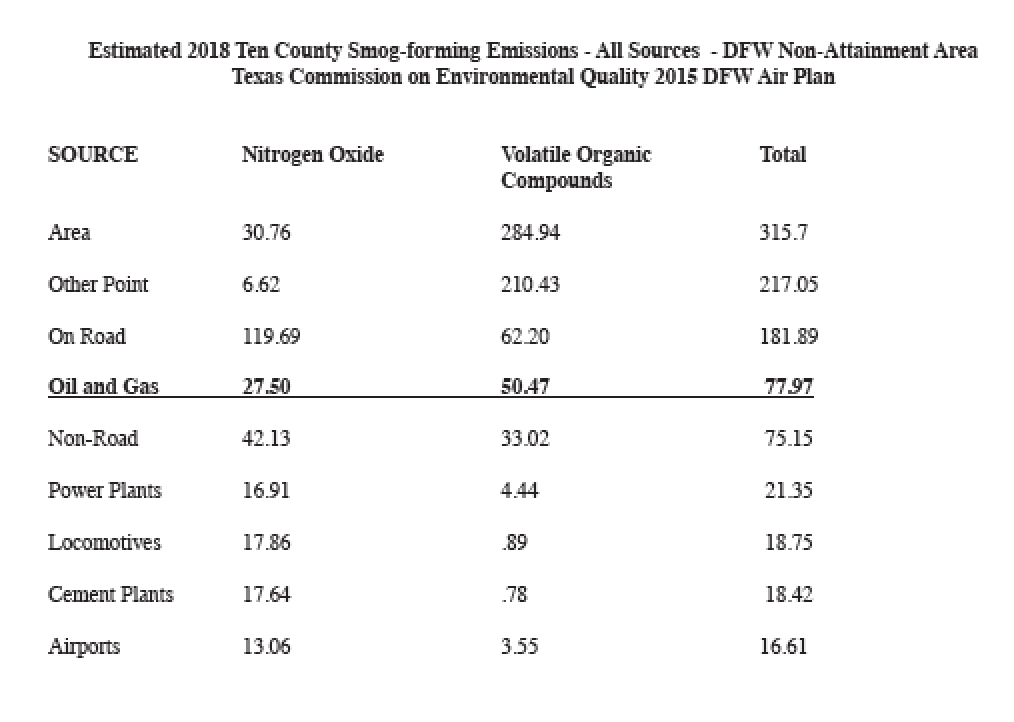
Oil and Gas pollution is the fourth largest category of smog pollution in North Texas. It's the fourth largest category for Nitrogen Oxide (NOx) pollution – the kind the State believes is most responsible for DFW smog. It's also the fourth largest source for Volatile Organic Compounds (VOCs), another kind of smog pollution that many of us believe plays a bigger role than the State thinks.
And these are the State's own numbers so you can be sure they're underestimates.
For example, a recent review of studies estimated that the Barnett Shale gas production was leaking up to twice as much climate-damaging methane as the EPA predicts. Methane doesn't escape by itself. If it's leaking, so are smog-forming VOCs that come up with the Methane.
Bottom Line: a huge new category of smog pollution has been created in DFW in just the last 8 years.
2. Oil and Gas Air Pollution is making DFW Smog Worse
Even the State admits that pollution from Barnett Shale industry sources contributes to DFW smog, the only disagreement is by how much.

Take a look at another chart – one that tracks the "average regional" smog level over the decades. Notice the downward trend that stops around 2009, where it continues to hover around 85 ppb? Can you think of anything that began happening in DFW in a big way around 2008-9 that would have stopped that downward trend?
Part of the problem is location. Historically, DFW's worst-performing air monitors, the places where the air quality always seems to be worse at the end of every "ozone action day" are located in the Northwest part of the Metromess – Keller, Grapevine, Denton, and Eagle Mountain Lake. Predominant winds are from the southeast to the northwest in summer time, pushing all of DFW's pollution toward Denton and Wise Counties.
Imagine what happens when you begin to envelope those same northwest areas into the country's largest urban gas field. In 2011, the State estimated that there was more VOC pollution coming from O&G sources in the region than from all the cars and trucks on the road in North Texas at the time.
This impact has not escaped EPA's notice. In official comments filed last February the Agency wrote that those Northwest monitors have not seen their ozone numbers come down as much as other parts of the region and suggest the sea of O&G pollution surrounding them may be the reason.
Thanks to the landmark UNT study that cloned the State's own computer air model for the DFW plan, we know exactly what kind of influence O&G pollution has on those monitors – or at least what the impacts are using the State's underestimated numbers.
If you took away all the estimated 2017 pollution from the Barnett Shale in DFW, you'd see drops in ozone of…
5.4 ppb at the Eagle Mountain Lake air monitor site
5.3 ppb in Keller
4.9 in NW Ft. Worth
3.6 ppb in Denton
These reductions in ozone would be enough to bring all of these DFW air monitor sites into compliance with the current 75 ppb standard, and allow all the sites except Denton to reach the new 70 ppb federal ozone standard more quickly than the deadline of 2025.
Conversely – you can see these numbers as the added smoggy burden the industry is imposing on DFW now. According to the State itself, O&G pollution are raising ozone levels as much as 3 to 5 ppb across large parts of the region.
3. Large Cuts in O&G Pollution = Less Smog in DFW
If oil and gas pollution is a large source of smog pollution, it makes sense that cutting that pollution would lead to less smog. Because of the UNT report, we know how much regional smog would decrease if we took some steps to stop down O&G pollution.
For example, just converting all 647 large gas compressors (point sources) in North Texas from diesel or gas to electricity – something the industry says it can do in areas with air pollution problems – would take over 16 tons of NOx pollution out of the air each and every day and lead to a drop of over 3 ppb at the Eagle Mountain Lake site and between 1 and over 2 ppb at 10 other air monitor sites. That may not sound like much, but it's enough to send most of them into compliance with the current 75 ppb standard. And that's not even accounting for the decrease in Particulate Matter pollution that would accompany such a transition. Because compressors are the industry's largest source of Nitrogen Oxides, they should be a big target for a new EPA air plan for DFW.
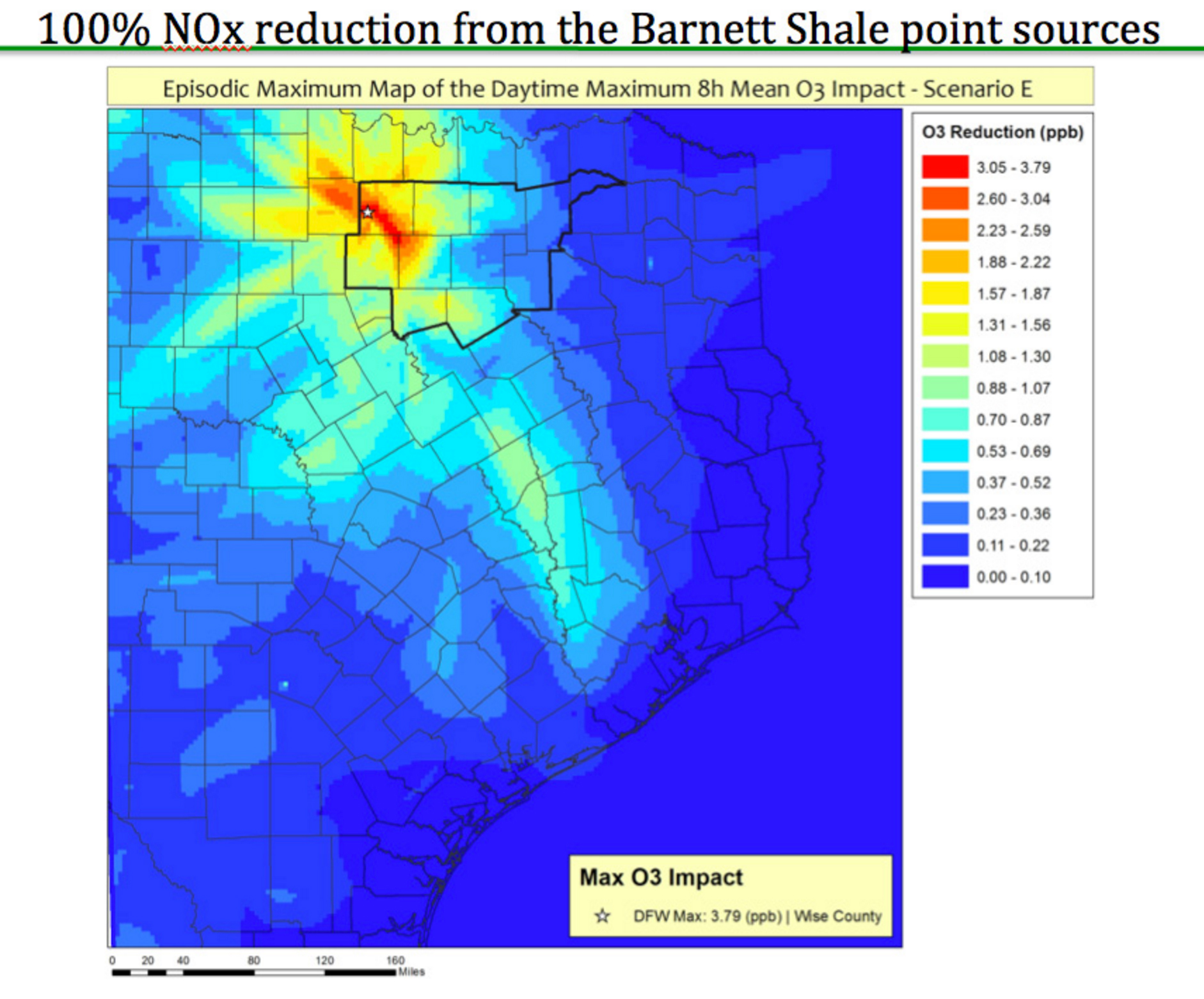 VOC pollution could also decrease under an EPA plan. Under the EPA's proposed new methane rules, there are a series of guidelines for controlling the pollutant that would also end-up cutting other smog-forming and toxic VOC pollution as a side-benefit. We're talking Benzene and all the other nasties the human eye can't see coming out of a storage tank or dehydrator.
VOC pollution could also decrease under an EPA plan. Under the EPA's proposed new methane rules, there are a series of guidelines for controlling the pollutant that would also end-up cutting other smog-forming and toxic VOC pollution as a side-benefit. We're talking Benzene and all the other nasties the human eye can't see coming out of a storage tank or dehydrator.
According to the Agency's release on the the new rules, “…reduction of VOC emissions will be very beneficial in areas where ozone levels approach or exceed the National Ambient Air Quality Standards for ozone." Areas like DFW – for the past two decades.
Under the new rules, areas like DFW that host large concentrations of gas pollution sources and are officially categorized as “non-attainment” for smog, could be the beneficiaries of new EPA-written “Control Technique Guidelines.”
According to EPA, these CTGs “provide an analysis of the available, cost-effective technologies for controlling VOC emissions from covered oil and gas sources. States would have to address these sources as part of state plans for meeting EPA’s ozone health standards.”
EPA gives states two years to include these controls in new air plans. Texas could include them now, in its current air plan, but it doesn't want to.
But if the EPA is writing our air plan instead, then these new VOC controls get put into the mix. Even a 50% cut in VOC emissions from the gas industry means 25 tons a day less air pollution from facilities over a wide area. That's worth fighting for.
If EPA rejects the state plan, it would take up to two years to implement a federal alternative. Even so, is there any other opportunity to cut as much oil and gas pollution in that amount of time? From new fedreal rules? Through local opposition? This is a chance to regionalize the fracking fight and reap large benefits.
Still steamed over HB40? Get mad AND get even.
Help us take the DFW air plan out of the State's hands, and give it to the EPA, where we can advance the cause in a way the state never dreamed of.
Thursday, January 21st
6:30
616 Six Flags Road in Arlington
THE CASE FOR EPA TAKEOVER OF DFW AIR PLAN
Sign the CHANGE.ORG petition to EPA urging the Agency to reject the State's plan.
The Fastest Way to Get Big Cuts in Climate Change Pollution? A Good DFW Anti-Smog Plan.
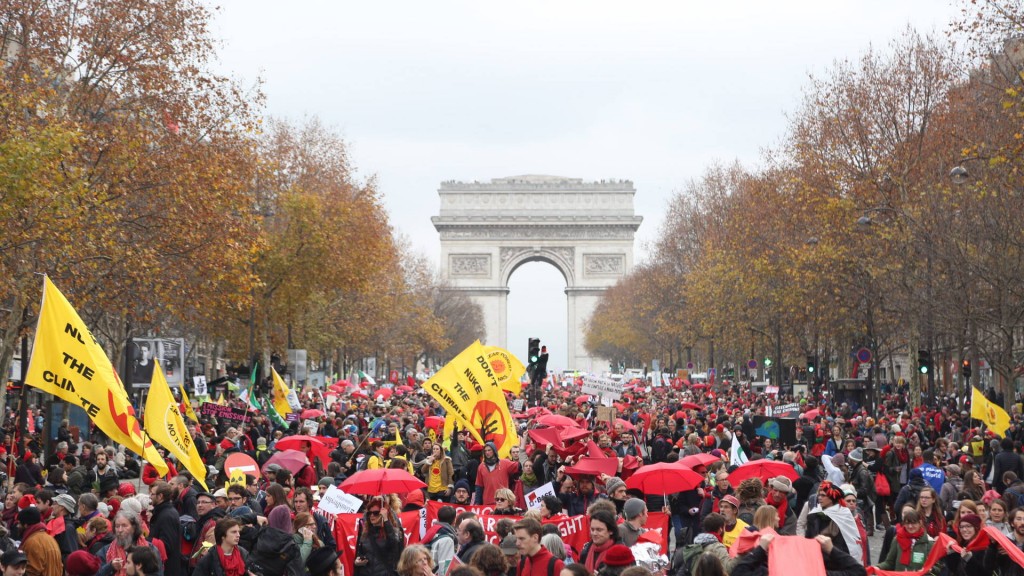
Public Hearing
6:30 pm Thursday
January 21st
616 Six Flags Drive Arlington
When polluters cut smog pollution, they cut a lot of other kinds of pollution as well, including climate-damaging gases like CO2 and methane.
Hundreds of thousands of tons of this kind of pollution could be eliminated in the next air plan for Dallas-Ft. Worth as a result of requiring modern controls on coal plants, cement kilns, and oil and gas sources.
Luminant's Martin Lake coal plant in East Texas is the largest global warming polluter in the country. It released 16.3 million metric tons of carbon dioxide in 2012, the equivalent of 3.5 million cars.
Recent studies show facilities in the Barnett Shale Gas Play are leaking 50% to 90% more methane than the government estimates.
We need to cut pollution here, now.
That's why if you care about climate change, you'll want to show-up next Thursday night and speak in favor of the EPA rejecting a State of Texas plan that doesn't require any new cuts in pollution from any source.
Join your earth-hugging peers in calling for a new air plan written by EPA that includes cuts in local smog pollution that can also benefit the entire planet. In as little as two years, you could make a big difference to a big problem.
Think Globally. Act Locally.
Not just a bumper sticker.
Additional Talking Points here if you need them.
SPECIFICS?
When the Ash Grove cement plant in Midlothian modernized its operations to conform with new anti-smog rules and other regulations, it cut approximately 300,000 tons of CO2 pollution – a year. That's just one cement plant.
Methane is the main ingredient in natural gas, and a highly potent greenhouse gas, with over 80 times the 20-year warming power of carbon dioxide.
EPA estimates 750,000 to one million tons of methane is released by equipment leaks every year from facilities in the Barnett Shale, but a recent peer-reviewed study estimated methane emissions in the Barnett Shale may be twice as high as EPA thinks.
There are pending EPA rules to limit methane pollution at natural gas sites that could be rolled into this DFW air plan. Even a 50% cut in leaks in North Texas would mean an annual drop of 400-500,000 tons of climate changing pollution.
A good anti-smog plan from EPA will also put more pressure on the obsolete East Texas coal plants to close.These coal plants are the biggest reasons Texas status is the #1 Greenhouse Gas polluter in the U.S.
The fastest way to cut lots of greenhouse gases in the Belly of the Beast is with a good EPA anti-smog plan for DFW.
Come speak in support of an air plan for our region that would help reduce asthma attacks here, and the melting of glaciers in Greenland.
Thursday, January 21st
6:30 pm
616 Six Flags Road in Arlington
First Floor Meeting Room
– Send EPA Administrators an email asking them to reject the State's do nothing DFW air plan and instead wrie one of their own.
– Sign the CHANGE.ORG Petition urging EPA to reject the State's air plan for DFW
It’s a Texas vs EPA Cage Match. Winner Takes All …The Air You Breathe
 JOIN OUR TAG TEAM EFFORT TO TAKE DOWN THE STATE OF TEXAS
JOIN OUR TAG TEAM EFFORT TO TAKE DOWN THE STATE OF TEXAS
BUT WATCH OUT – THEY PLAY DIRTY
NEXT THURSDAY EVENING
JANUARY 21st
6:30 PM
616 Six Flags Road
First Floor HQ of the
North Central Texas Council of Governments
There's an important bureaucratic cage match between EPA and the State over how clean your air should be.
The state says just by hitching a ride on already-in-progress federal gasoline mix for cars and trucks, DFW ozone, or smog, will drop to levels "close enough" to the current federal smog standard of 75 parts per billion (approximately 78 ppb) . No new cuts in pollution required.
The EPA says not so fast – "close enough" may not be good enough this time around and you're not following the Clean Air Act in laying back and requiring no new cuts in pollution.
EPA has told Austin a failure to follow Clean Air Act rules will force it to take responsibility for the plan away from the State.
Is this something you want? If so, you should show up and next Thursday evening to give the EPA the political support it needs to pull the rug out from under the State.
WHAT HAS THE EPA ALREADY SAID ABOUT THE STATE'S PLAN?
Along with comments from DFW residents, environmental groups, doctors, industry and elected officials, EPA itself will weigh-in with written comments on the TCEQ plan by the deadline of January 29th.
But we don't have to wait that long to find out what EPA really thinks about what the State is proposing. Last year, EPA provided 11 pages of comments on exactly the same plan.
1) This plan won't work without more cuts in pollution
What EPA Said:
"Based on the monitoring data and lack of additional large reductions in NOx within areas of Texas that impact DFW, it is difficult to see how the area would reach attainment in 2018 based solely on federal measures reductions from mobile and non-road….The recent court decision that indicates the attainment year will likely be 2017 for moderate classification areas such as DFW, makes it less clear that the area will attain the standard by 2017 without additional reductions."
What EPA Meant:
It wasn't looking good when the deadline for reaching the 75 ppb standard was 2018 and the State didn't require any new cuts in air pollution, but now that the deadline is 2017, your do-nothing "close enough" plan is even less likely to work.
2) Your case for doing nothing isn't very good
What EPA Said:
"While the State has provided a large chapter on Weight of Evidence, the principal evidence is the recent monitor data. The monitor data does not show the large drops in local ozone levels and therefore raises a fundamental question whether the photochemical modeling is working as an accurate tool for assessing attainment in 2018 for DFW."
What EPA Meant:
Actual measurements of smog in DFW seem to undercut your claim that the air is getting cleaner faster. Maybe your computer model that's driving the entire plan isn't all that great. (And this was before smog levels went UP after the summer of 2015 – something not predicted by the State's model….)
3) Review pollution limits for the Midlothian cement kilns, or we'll reject your plan
What EPA Said:
"Because of significant changes in the type and number of cement kilns in Ellis County,…TCEQ's rules need to be reevaluated to insure these reductions are maintained, and the emission limits reflect a Reasonably Available Control Technology (RACT) level of control as required by the Clean Air Act…Failure to conduct a thorough RACT analysis for cement kilns which would include appropriate emission limits would prevent us from approving the RACT portion of the attainment plan submittal."
What EPA Meant:
Update your kiln pollution limits, or this part of the plan is toast. (Texas chose not to perform this update, in essence, giving EPA the bureaucratic finger.)
4) Oil and Gas pollution seems to be keeping the region's smog levels higher than they should be
What EPA Said:
"Recent NOx trends (Figure 5-10 in TCEQ's Proposal) indicate a fairly flat NOx trend for several NO monitors in the western area of the DFW area (Eagle Mtn. Lake, Denton, and Parker County monitors). These monitors are in areas more impacted by the growth in NOx sources for Oil and Gas Development that seem to be countering the normal reduction in NOx levels seen at other monitors due to fleet turnover reductions (on-road and Nonroad). These higher NOx levels in the modeling domain that seem to be fairly flat with no change since 2009
raise concern that the area is not seeing the NOx reductions needed to bring the ozone levels down at these monitors."
What EPA Meant:
Since the historically worst-performing air pollution monitors in DFW are located in exactly the same area as a lot of gas and oil activity, and these monitors haven't been seeing the expected decrease in smog you predict, maybe you ought to think about cutting pollution from those oil and gas sources. Like we said, this plan needs more cuts in pollution.
5) Your own evidence supports cuts in pollution from the East Texas Coal Plants
What EPA Said:
"The TCEQ provided an evaluation of emissions from all of the utility electric generators in east and central Texas. However, the discussion in Appendix D on the formation, background levels, and transport of ozone strongly supports the implementation of controls on NOx sources located to the east and southeast of the DFW nonattainment area. How would a reduction in NOx emissions from utility electric generators in just the counties closest to the eastern and southern boundaries of the DFW area impact the DFW area?"
What EPA Meant:
Despite your protests, the State's own analysis shows cuts in pollution from the East Texas Coal Plants have a big impact on DFW smog levels and supports the argument for putting new controls on them. Did you actually run your fancy-dancy computer model to see what would happen if you did that? (No, the State did not. But UNT and Downwinders did.)
WHY WOULD AN EPA PLAN FOR DFW AIR MAKE ANY DIFFERENCE?

If the EPA rejects the State's plan, the clock begins ticking: the State is warned it has to write a new plan and, meanwhile, EPA begins to write its own. If the State doesn't turn in a plan the EPA finds acceptable in 24 months, the EPA plan is implemented instead.
The State has no interest in any new cuts of pollution from any sources. It thinks it's plan is already "close enough."
If the EPA is writing the plan, citizens can use the new UNT study to show the Agency which cuts get the largest drops in smog – using the State's own air model.
We can use Dr.Haley's study to show the approximate economic and public health benefits of those cuts.
More change happens if EPA is writing the plan.Enough to finally get DFW safe and legal air? We don't know until we try. The alternative is doing nothing.
The Most Important Local Environmental Hearing of the Year?
 A Public Hearing about the Air YOU Breathe
A Public Hearing about the Air YOU Breathe
Thursday, January 21st
Public Comment begins at 6:30 pm
616 Six Flags Road, Arlington
(HQ of the North Central Texas Council of Governments)
What makes this hearing so important?
Well, it's not the fact the state is hosting it. Nobody expects the State to care about this hearing, except as a legal formality
It's important because the EPA will be there listening. It's never taken a clean air plan away from the state before. it's a big step. It will be controversial. They need to see DFW residents asking for them to do it. They need to feel they have the political support to go through with such a drastic action.
It's important if you or anyone you know suffers from asthma or other respiratory illnesses that get worse when the air is dirty. Dr. Robert Haley of UT-Sothwestern Medical School has a new study showing just a small drop in North Texas smog can have huge health benefits and savings.
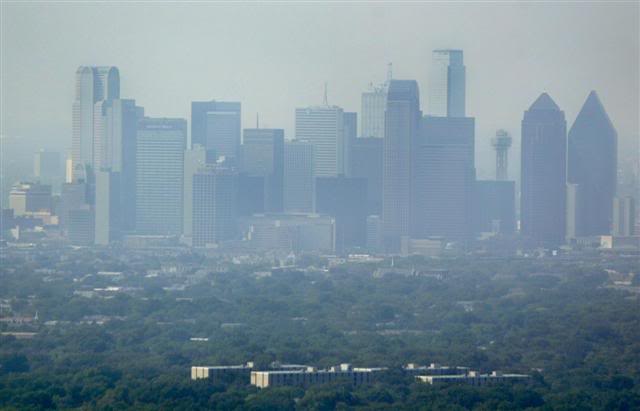 What Can I Do?
What Can I Do?
1. Show-up at the hearing on the 21st and tell EPA you want them to write their own clean air plan for DFW – use the talking points below.
2. Spread the word about this hearing. Forward this call to action to other folks. We only have two weeks to organize.
3. Watch and forward our two and a half minute "SOS@EPA" video– it makes the case for why we need EPA's help…to a steady disco beat.
4.Sign the Change.Org petition calling for EPA to reject the state air plan and write one of its own
5. Send an email to EPA telling them the same thing.
______________________________________________
Show Up to Tell EPA to Take DFW's Air Plan Away From the State
1. The Dallas-Fort Worth area has been in continual violation of the federal Clean Air Act for ozone, or smog pollution, since 1991.
2. DFW is currently classified as a "non-attainment area," or not complying, with the current federal eight-hour ozone pollution standard of 75 parts per billion (ppb), (a standard now considered to be inadequate and soon to be replaced by a lower 70 ppb standard)
3. According to the USEPA, DFW will be one of only ten non-California metropolitan areas still in violation of the Clean Air Act, and the new federal ozone standard of 70 ppb, in 2025 without additional reductions in pollution.
4. DFW's regional annual smog pollution average increased from 81 ppb in 2014 to 83 ppb in 2015. Our smog got worse last year.
5. Dallas-Fort Worth now has a higher annual smog level than Houston.
6. According to a Cook Children's Hospital study, Dallas-Forth Worth has childhood asthma rate three times the national average. 
7. Computer air modeling by the Texas Commission on Environmental Quality (TCEQ) predicts its DFW clean air plan will still leave at least four North Texas monitors with annual averages exceeding 75 ppb of ozone pollution at its conclusion – including one at 77.8, or 3 ppb higher than an old standard we know isn't protective. TCEQ's plan doesn't even reach the goal it's supposed to meet.
8. In official comments, the USEPA has stated that TCEQ's proposed DFW clean air plan will not be effective"without additional reductions" in smog-forming pollution, and warned that the State's refusal to comply with certain Clean Air Act requirements make the plan unacceptable. TCEQ's proposed DFW clean air plan requires no such additional reductions.
9. In 2011, the last TCEQ clean air plan that required no new pollution controls left ozone levels higher than when it began – the first time any clean air plan for DFW had done that.
10. Members of the Engineering Department of the University of North Texas (UNT) have, with TCEQ cooperation, replicated the State's computer air pollution model for the DFW clean air plan, and used it to study how additional controls at major sources of smog pollution could reduce ozone throughout the Dallas-Fort Worth non-attainment area.
Results from the UNT study demonstrate additional controls at selected major sources of pollution would significantly reduce DFW ozone levels, including Selective Catalyst Reduction at Midlothian cement kilns and East Texas coal plants, and electrification of large natural gas compressors in the Barnett Shale.
The UNT study demonstrates a clean air plan for DFW that includes these controls would meet or exceed the current ozone standard of 75 ppb at all North Texas air monitors.
11. A 2015 study by University of Texas Southwestern Medical Center's Director of Epidemiology, Dr. Robert Haley, estimates a 5 ppb reduction in ozone pollution would result in economic savings of $650 million a year and prevent 100 deaths annually throughout Northeast Texas12. In 2015, the Texas Medical Association officially requested USEPA to reject TCEQ's proposed DFW clean air plan and substitute one which "conforms to the scientific, peer reviewed modeling methods developed by UT Southwestern and University of North Texas experts.… (and) implementing reasonably available control measures at the state level capable of meeting national ozone standards, based on the UTSW and UNT validated models."
12. In 2015, the Texas Medical Association officially requested USEPA to reject TCEQ's proposed DFW clean air plan and substitute one which "conforms to the scientific, peer reviewed modeling methods developed by UT Southwestern and University of North Texas experts.… (and) implementing reasonably available control measures at the state level capable of meeting national ozone standards, based on the UTSW and UNT validated models."
13. Over the last 20 years, and five different plans, the State of Texas has never succeeded in bringing DFW into compliance with the Clean Air Act. It's time to let EPA try – they can't do any worse.
14. EPA just released a Federal clean air plan for haze pollution in parks after the state refused to provide an adequate one of its own. That's great. It should now write one for the seven million people of the DFW area. We deserve at least as much protection from the state's willful contempt for the Clean Air Act as parkland.

